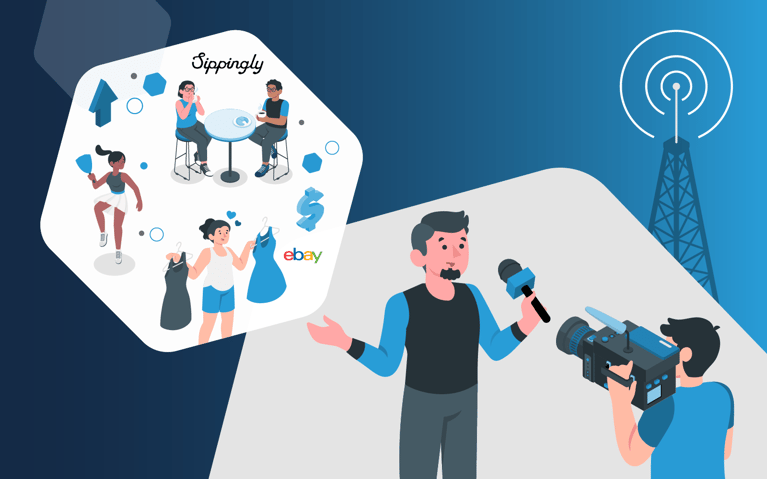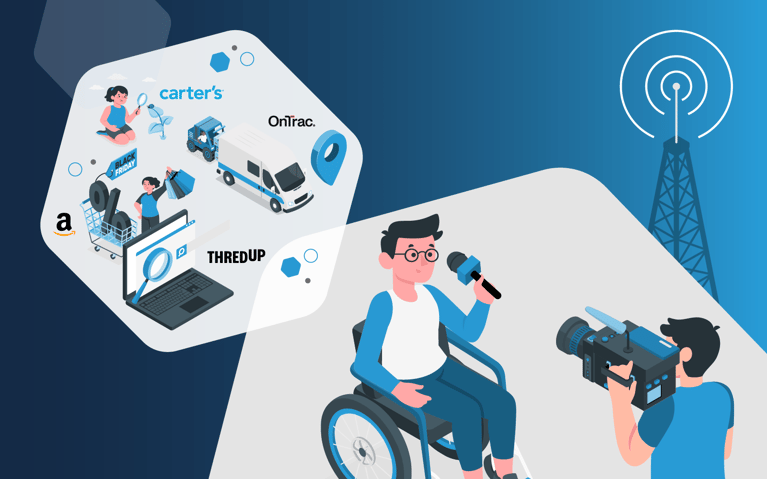The Fashion ReModel initiative helps brands embrace circularity, U.S. ecommerce hits Q1 high and Target turns UGC into inspiration for new campaign. Plus, Google’s new AI overview to incorporate Shopping ads and Walmart works to match Amazon’s shipping speeds.
In this week’s news, shoppable content is on the rise, notable brands are looking to cut overproduction and join the circular economy and Google continues search its transformation. Plus, Walmart’s shipping speeds increase, and Target captures “That Target Feeling” from real shoppers. Visit our blog every week for a roundup of the latest commerce news.
Google’s new AI Overviews to bring Shopping ads as part of search transformation
You may have noted a change to your Google search results recently. Google has been rolling out AI Overviews in Search to all users in the U.S., with more countries to follow. These AI Overviews provide enhanced search results, leading to more diverse website visits and higher quality clicks compared to traditional listings. Users engaging with AI Overviews tend to use Search more frequently and are more satisfied with their results, spending more time on linked sites. The AI Overviews also benefit publishers by driving valuable traffic. Google will soon test integrating Search and Shopping ads within AI Overviews,1 clearly marked as “sponsored,” without requiring any action from advertisers. According to Google, “Ads from existing Search, Performance Max and Standard Shopping campaigns have the opportunity to appear within the AI Overview.” These ads will be relevant to both the search query and the AI Overview content. Google aims to continue refining these formats based on feedback from advertisers and the industry.
The Fashion ReModel initiative aims to help notable brands cut overproduction
The Ellen MacArthur Foundation (EMF)2 has launched the Fashion ReModel initiative at the Global Fashion Summit in Copenhagen, urging brands to embrace circular business models such as rental, resale, repair and recycling to reduce reliance on new clothing production.3 This initiative aims to decouple revenue from new garment production, promoting a circular economy in fashion. Brands like Arc’teryx, Reformation, Primark and H&M Group (including Weekday, Cos and Arket) have committed to increasing their revenue from circular models over the next three years and will report progress to EMF annually.
The first year will focus on climate impact evidence and finance metrics, with policy considerations coming later. EMF’s roadmap for this project follows consultations with over 80 industry stakeholders. The initiative's success is expected to mirror the growth of EMF’s previous project, 'The Jeans Redesign', which expanded from 16 to over 100 organizations. Despite the fashion industry’s historical overproduction and low transparency – highlighted by Fashion Revolution’s 2023 Transparency Index showing only 38% brand transparency in circular initiatives – EMF hopes this project will build confidence and demonstrate the feasibility of circular models, ultimately setting higher standards for sustainability. The initiative has garnered support from several multi-stakeholder groups, signaling a significant shift toward sustainable fashion practices.
U.S. Ecommerce hit an all-time first quarter high
The Census Bureau reported that U.S. retail ecommerce sales for Q1 2024 were $289.2 billion, a 2.1% increase from Q4 2023.4 Total retail sales for Q1 2024 were $1,820.0 billion, slightly down by 0.1% from Q4 2023. Compared to Q1 2023, ecommerce sales grew by 8.6%, and total retail sales rose by 1.5%. Ecommerce accounted for 15.9% of total sales in Q1 2024. On an unadjusted basis, ecommerce sales were $268.1 billion, down 17% from Q4 2023, but up 8.5% from Q1 2023, making up 15.6% of total sales.
The race to deliver: Walmart’s takes aim at Amazon with same-day and one-day delivery
In a recent earnings call,5 Walmart talked about their delivery achievements. Over the past year, Walmart delivered 4.4 billion items with same-day or next-day shipping in the U.S., with 20% of these deliveries completed in under three hours, according to CEO Doug McMillon. CFO John David Rainey noted that enhanced delivery speeds have increased online orders, boosting delivery efficiency and reducing net delivery costs per order by nearly 40%. Internationally, Walmart saw significant improvements, with same-day orders in India up over 150% and one-hour delivery in China reaching 55 million orders. Walmart's strategy, utilizing its 4,600 U.S. stores for same-day deliveries, has allowed it to meet online demand efficiently and reduce delivery costs through increased customer base and last-mile parcel stations. It also allowed Walmart’s same-day and next-day volume to compare favorably to key competitor Amazon.
Target’s new campaign inspired by real shoppers and UGC
Target has launched a new marketing campaign, “That Target Feeling,” inspired by real customer experiences and set to a reimagined version of Michelle Branch's 2001 hit, "Everywhere."6 The campaign highlights the joyful, everyday moments that make Target special, such as finding the perfect barbecue outfit or a limited-edition Stanley cup. It will be featured across digital, audio, social and streaming channels, and hopes to evoke laughter and nostalgia.
“We know Target is the happy place for millions of guests, and we’re excited to show what that looks and feels like through their eyes,” said Lisa Roath, chief marketing officer. “This campaign is inspired by real experiences shoppers have shared on social — those small, fun, and sometimes unexpected moments of discovery and delight in our aisles that make us Target. We’re lifting that joy up in our marketing this year as we continue leaning into nostalgia and humor in new ways.” Target, frequently mentioned over 50,000 times daily on social platforms and the most-followed big-box retailer on TikTok, showcases relatable skits inspired by user-generated content (UGC). The campaign, launched on May 19, includes collaborations with creative agency Mythology and director Ibra Ake from Somesuch. It also features products that will be available on the Target Finds page, organized by campaign themes. Storytelling and UGC has become a crucial part of marketing. It helps create an emotional connection between the brand and the audience, making the message more memorable and engaging. By weaving narratives that resonate with consumers, brands can effectively convey their values and differentiate themselves.
Shoppable content enabling retailers to reach consumers at lower-intent moments
Consumers increasingly expect to make purchases at the point of discovery, prompting publishers and retailers to adapt. On a recent earnings call, BuzzFeed highlighted how shoppable content helps retailers reach consumers during lower-intent moments, finding new audiences.7 CEO Jonah Peretti explained that visitors often discover shopping content while on BuzzFeed for other reasons, sometimes shopping for fun rather than with specific purchases in mind. BuzzFeed plans to leverage generative AI for personalized commerce features, such as dynamically inserted product recommendations. Despite a 9% year-over-year revenue drop in its "commerce and other revenues" segment, BuzzFeed sees potential in these strategies. Integrating shopping into content is becoming essential as traditional retail sites lose effectiveness, and consumers increasingly expect seamless, immediate online shopping experiences. This trend underscores the growing importance of shoppable content in meeting consumer expectations and shortening the path to purchase.
References:
- https://blog.google/products/ads-commerce/ai-creativity-google-marketing-live/
- https://www.ellenmacarthurfoundation.org/the-fashion-remodel/overview
- https://www.voguebusiness.com/story/sustainability/is-fashion-finally-ready-to-cut-overproduction-hm-reformation-zalando-ellen-macarthur-foundation
- https://www.census.gov/retail/ecommerce.html
- https://seekingalpha.com/article/4693881-walmart-inc-wmt-q1-2025-earnings-call-transcript
- https://corporate.target.com/news-features/article/2024/05/that-target-feeling-marketing-campaign
- https://www.pymnts.com/news/ecommerce/2024/publishers-integrate-commerce-consumers-demand-shopping-wherever-whenever/
Subscribe to our emails for the latest industry insights!
By entering your email, you agree to receive marketing emails from Cart.com




.png?width=1940&height=180&name=better%20software%20(1).png)



